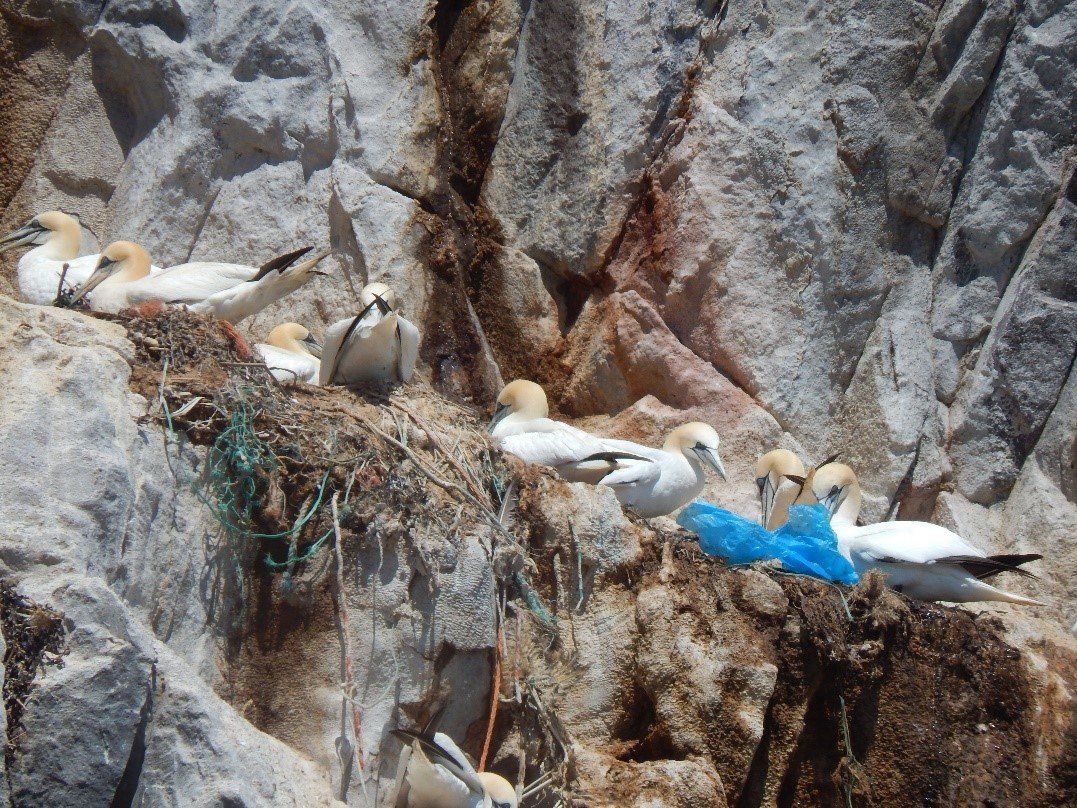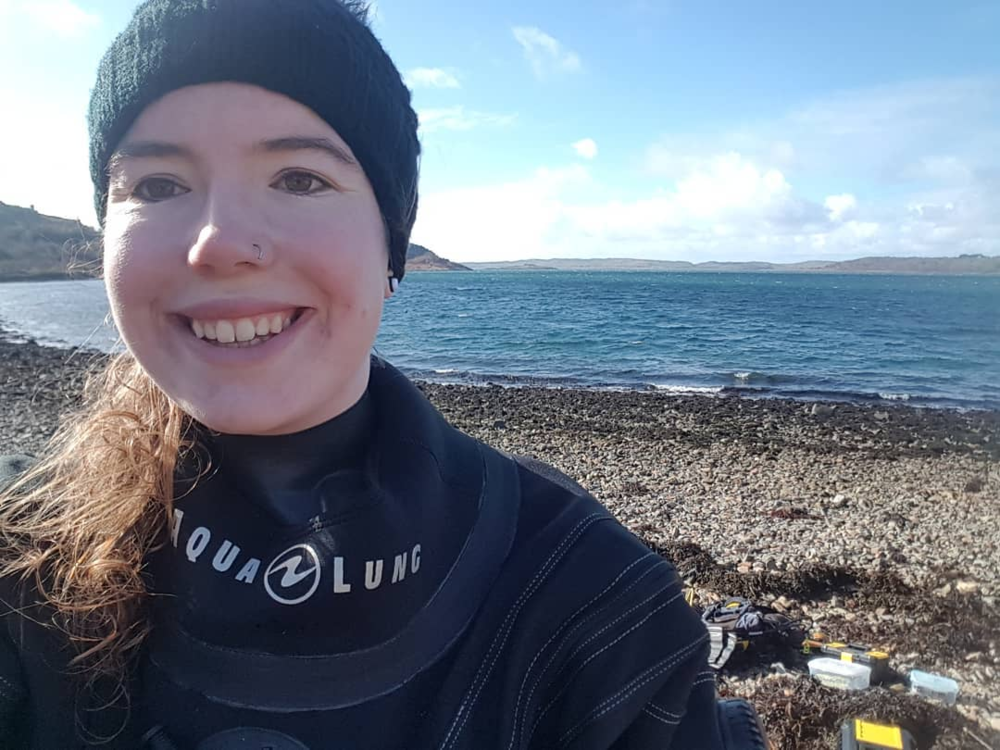PLASTIC IN NESTS IS ABSOLUTE RUBBISH!
Lottie Glover | 15th of September 2020.
Marine debris (including plastics) impacts of a wide range of organisms from crustaceans to whales. It is estimated that there are 269,000 tonnes of plastic floating on the ocean’s surface (this is the weight of nearly 1,500 blue whales). Recent studies have found plastic in100% of sea turtles, 59% of whales and 36% of seals. 36% of seabird species are impacted by entanglement, and 39% have ingested debris.
Gannets, boobies and cormorants seem to be particularly susceptible to entanglement. However, the probability of detecting entanglement is low, so monitoring the risks to seabirds can be challenging.Many seabird species incorporate marine debris into their nests. One possible theory for this is the similarity of some debris, such as ropes and netting, to natural nesting materials like seaweed and twigs. Looking at marine debris incorporation in seabird nests may allow scientists to predict local levels of debris pollution.
The Northern Gannet,
Morus bassanus, is the largest species in the Sulidae family (gannets and boobies). They are found across the coasts of the Northern Atlantic, breeding in Western Europe, EasternNorth America and the Caribbean. Their wingspan is 170-190cm and they can reach speeds of up to 40mph in flight. When diving for food, they can hit the water at speeds of up to 62mph, typically from 10-40m above the water’s surface. BassRock in Scotland is the largest breeding colony of Northern Gannets, with around 75,000 breeding pairs. Nesting begins in March/April and they lay one egg which is incubated for 42-46 days, with the chick fledging at around 90days old. Gannets reuse their nests for several years, and they can form large structure up to 100cm tall, accumulating a variety of materials.
A study by O’Halon
et al., 2020, monitored the nest incorporation of anthropogenic debris by Northern Gannets across their range. 29 gannet colony sites were used in Canada, UK, Ireland, Iceland, Italy,Germany, Norway and the Faroe Islands. A range of monitoring methods were used including visual observations by one of the authors themselves, aerial photographs, visual observations from other observers, photographs and publish data. The frequency occurrence (FO) of nests containing visible debris was recorded. The surface area of each nest to the nearest 5 % (or nearest 1% when the percentage was below 10) was estimated. The debris was categorised into type (sheet, thread, foam, hard, other) and potential source (fishing, consumer items, unknown). Marine Conservation Society (MCS) beach clean data was used where possible to monitor local debris pollution. The Global Fishing Watch was used to collect fishing activity data.
The results of the study found that 46% of the 7280 monitored nests contained debris. Debris was detected in nests in all but one colony, Machias Seal Island in Canada. There was a large variation infrequency occurrence across the range. FO correlated with the size of the nest, i.e. the higher the FO, the larger the nest. Most nests had 1-10% of the surface area covered in debris, with a few nests having over 50% of their surface covered.
The type and potential source of debris was only available for 5842 nests, with 45% of these containing debris. Threadlike plastic was the most frequent type of material noted, found in 45% of all nests, so was present in all nests that contained debris. This material was mostly rope and netting, likely from fishing activities. Colonies located in areas with higher fishing effort within 100km of the colony had a higher occurrence of debris in the nests than those in lower fishing effort areas. MCS beach clean data was available within 20km of 8 colonies. The debris found on nearby beaches was dissimilar to what was found in gannet nests. This suggests that Northern Gannets actively select for threadlike material for their nests, possibly due to the similarity to seaweed and grass.
The authors suggest that the variability in the number of nests in each colony containing debris could partly be influenced by local fishing activity. Due to the Northern Gannet showing selectivity to threadlike plastics, they are not a suitable indicator species to monitor local marine debris. However, they may be useful in monitoring local fishing related debris. Two Northern Gannet colonies in Newfoundland, Canada, have seen a significant decline of debris incorporated into nests since the closure of a local fishery.
It was noted that colonies that had established more recently had fewer nests with debris. Those nests on the periphery of the colony also had less debris in, likely due to these being established more recently than those nests in the core of the colony that have been built up over several years. Size and/or mass of the debris was not known, so the study could not estimate the amount of debris found within individual nests. Other factors such as prevailing winds and currents were not considered, which may affect the accumulation of marine debris in certain areas.
The colony in the Faroe Islands found 112entangled individuals in from 2018-2019. Other species that share nesting sites with gannets have also been found tangled in the gannet’s nests, such as theCommon Guillemot. Previous studies have suggested that entanglement is unlikely to have any population-level effects of entanglement, however we still do not have a full understanding of entanglement yet due to a lack of quantitative data. Regular recording of entanglement could provide more detail about the potential risk it poses to gannets and their population.
Annual monitoring should occur as this coulddetect changes in debris in nests over time. Local and national incentives areneeded to reduce abandoned, lost and discarded fishing gear. Legislations arealso needed for recycling targets and deposit schemes.
Reference:
O'Halon, N. J., Bond, A. L., Lavers, J. L.,
Masden, E. A. and James, N. A. Monitoring nest incorporation of anthropogenic
debris by Northern Gannets across their range. Environmental Pollution
. 225
, 113152
















